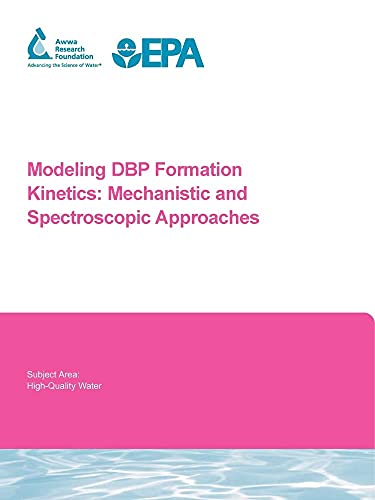Modeling Dbp Formation Kinetics: Mechanistic and Spectroscopic Approaches (Water Research Foundation Report Series) - Tapa blanda

Book by Korshin G Benjamin M Chang H
"Sinopsis" puede pertenecer a otra edición de este libro.
Reseña del editor:
Numerous statistical models for DBP formation kinetics exist, along with a smaller number of mechanistic models. These models require extensive calibration, and their applicability under conditions that differ from those used in the calibration is questionable (especially the statistical models). Models that are scientifically defensible and that have a tractable number of fitting parameters are needed. Virtually no data have been collected for DBP formation at very short reaction times. The primary objective of this project was to develop a mechanistic kinetic model of THM and HAA formation consistent with current understanding of the reaction mechanisms. Ideally, the model would account for the effects of Cl dose, pH, temperature, and bromide concentration on DBP formation kinetics and speciation. Secondary objectives included the study of DBP formation at very short reaction times (< 1 s) and development of a model for DBP formation as a function of the changes in absorbance of the sample upon chlorination. The experimental approach involved chlorinating baseline (Lake Washington) water under a range of conditions of pH, Cl dose, temperature, and bromide concentration, and analyzing DBP formation and absorbance over time. Similar experiments were conducted using other source waters, but under a much smaller range of experimental conditions. Experiments were also conducted using stopped-flow and quench-flow instrumentation to study the reactions at times from 0.01s to 100s. A reasonable mechanistic model for the DBP formation reactions was postulated, and parameter values were sought that would cause the DBP formation predicted by the model to correspond to those obtained in the experiments. The experimental results, especially those for waters with very low bromide concentrations, could be reproduced quite well by the mechanistic model. To achieve that objective, two kinetically distinct sites had to be postulated for low-Br waters, and three had to be postulated for waters containing significant Br. The first step in the reaction sequence (reaction of halogen with the unaltered NOM) was rate-limiting for formation of all DBPs. HOBr reacts with both unaltered and halogenated NOM considerably faster than does HOCl.
"Sobre este título" puede pertenecer a otra edición de este libro.
- EditorialAwwaRF
- Año de publicación2005
- ISBN 10 1843398958
- ISBN 13 9781843398950
- EncuadernaciónTapa blanda
- Número de páginas184
(Ningún ejemplar disponible)
Buscar: Crear una peticiónSi conoce el autor y el título del libro pero no lo encuentra en IberLibro, nosotros podemos buscarlo por usted e informarle por e-mail en cuanto el libro esté disponible en nuestras páginas web.
Crear una petición